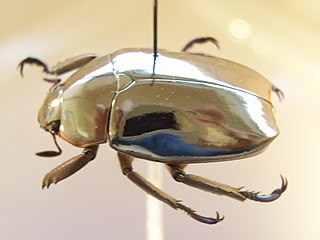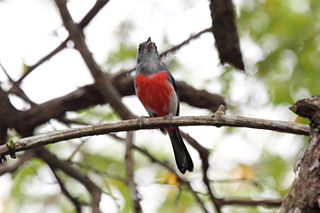
The ruteline genus Chrysina, or jewel scarabs, is a large genus of brightly colored, often metallic iridescent species, ranging from the southwestern edge of the United States as far south as Venezuela and Ecuador. The genus includes all the species formerly known as Plusiotis. They are typically between 15–35 millimetres (0.59–1.38 in) in length, and are nocturnal in habits, coming readily to lights. The larvae live in rotting logs, while the adults commonly feed on foliage; they tend to be found in pine, juniper, or pine-oak forests, most commonly between 1,000–3,000 metres (3,300–9,800 ft) elevation. They are most diverse in countries such as Guatemala, where as many as 15 species can be found in a single location, but there are only 4 species which occur in the United States.

The slaty-breasted tinamou or Boucard's tinamou is a type of tinamou commonly found in lowland moist forests of Mexico and Central America.

Amazilia is a hummingbird genus in the subfamily Trochilinae. It is found in tropical Central and South America.

The mangrove hummingbird is a species of hummingbird in the family Trochilidae. It is found only in Costa Rica. Its natural habitat is subtropical or tropical mangrove forest. It is threatened by habitat loss. The mangrove hummingbird feeds primarily on nectar from the flowers of the tea mangrove Pelliciera rhizophorae. Mangrove hummingbirds are occasionally seen in adjacent non-mangrove habitats. Nesting for these birds has been recorded during the months of October through February. The mangrove hummingbird is on average approximately 10 cm (3.9 in) long.

The grey-throated chat is a species of bird in the family Cardinalidae, the cardinals or cardinal grosbeaks. It is found in Belize, Guatemala, and Mexico.

Chrysina gloriosa is a species of scarab whose common names are glorious beetle and glorious scarab. The adults are 25 to 28 millimetres long and are bright green with silver stripes on the elytra. These iridescent stripes on the cuticle of the elytra are a result of cholesteric liquid crystal organization of chitin molecules. The differences in color are a result of the microscopic structure of each section, with green reflected from cusp-like structures and silver reflected from flat layers parallel to the surface of the elytra. As established through Mueller matrix spectroscopic ellipsometry, the optical properties change with the incidence angle of the propagating light. The polygonal cells in the green stripes generate self-healing Bessel beams. The adults eat juniper leaves at a high elevation and are able to camouflage by blending in with plants. The species is sometimes incorrectly thought to be endangered, but has never been listed either in the IUCN Red List of Threatened Species or under the United States Endangered Species Act. An invalid synonym used to be Plusiotis gloriosa.

Chrysina resplendens is a scarab beetle found in Costa Rica, Panama, El Salvador and other countries in Central America.
The Balsas shiner is a species of freshwater fish endemic to Mexico.

Arca is a genus of saltwater clams in the family Arcidae, the ark clams.

Rutelinae or shining leaf chafers is a subfamily of the scarab beetles. It is a very diverse group; distributed over most of the world, it contains some 200 genera with over 4,000 described species in 7 tribes. A few recent classifications include the tribe Hopliini, but this is not generally accepted.

Pelliciera rhizophorae, known as the tea mangrove, is a less-common species of mangroves found along the Pacific coast from the Gulf of Nicoya in Costa Rica to the Esmeraldas River in Ecuador, as well as within stands located in Nicaragua, Panama, and Colombia. During eras such as the Cenozoic, the species was prevalent. The mangrove hummingbirds of Costa Rica live off the relatively large quantity of nectar produced by its prolific blooms. Pelliciera rhizophorae is the only species in the genus Pelliciera which was previously recognized as the only genus in the family Pellicieraceae, but is now included in the family Tetrameristaceae.
Acrolophus boucardi is a moth of the family Acrolophidae. It is found in Mexico.
Dorcadion boucardi is a species of beetle in the family Cerambycidae. It was described by Pic in 1942. It is known from Syria.

Chrysina aurigans is a species of scarab beetle found in Costa Rica. It is notable for its golden color.
Chrysina beraudi is a species of beetle in the family Scarabaeidae, found in Costa Rica.
Rutelini is a tribe of shining leaf chafers in the family Scarabaeidae. There are about 14 genera and at least 40 described species in Rutelini.
Chrysina lecontei, or Leconte's chrysina, is a species of shining leaf chafer in the family of beetles known as Scarabaeidae.

Chrysina woodi, or Wood's jewel scarab, is a species of shining leaf chafer in the family of beetles known as Scarabaeidae. The name was first published in the minutes of a meeting in 1884 as woodi, in advance of the formal description of the species as woodii in 1885, but under ICZN Article 50.2, the 1884 name and spelling take precedence.

Chrysina adolphi is a species of ruteline scarab beetle from central America. They are found in the Sierra Madre del Sur in the Mexican states of Guerrero and Oaxaca where they feed on the leaves of Quercus species. Adults emerge from July to September.











